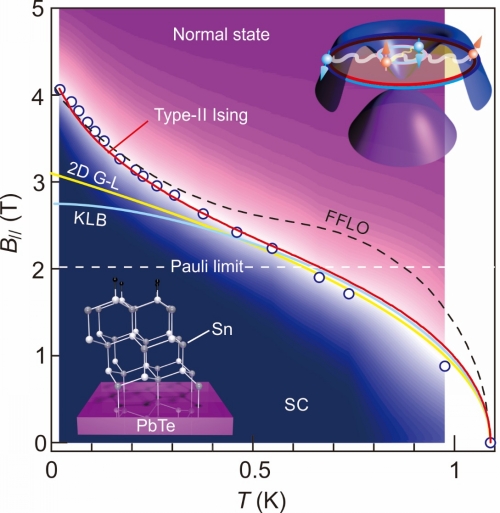The critical magnetic field of a superconductor defines the field that can turn the superconducting state to the normal state. It is one of the basic properties of superconductivity and an important indicator of the superconductor’s potential for applications. Mercury—the very first superconductor—has a critical magnetic field of merely tens of milli-Tesla. In recent years, people discovered that certain films with the thickness of a few atomic layers can sustain their superconducting state even under a magnetic field of tens of Tesla, far exceeding the expectation.
To explain this phenomenon, researchers proposed Ising pairing mechanism, in which the paired electrons have their spin orientations locked because of the broken inversion symmetry in the lattice of special types of materials. Under this framework, people searched in the non-centrosymmetric materials and found a few more superconductors with very large upper critical fields. However, some people believed that this effect can be solely attributed to dimension reduction, challenging the Ising pairing mechanism. Furthermore, an important prediction of Ising pairing—a divergent critical magnetic field at low temperature—has not been verified up to now.
Recently, a China-Germany collaborative team led by A/Prof. Ding Zhang and Prof. Qi-Kun Xue of Department of Physics, Tsinghua University, has overturned the boundary set by former theories, for the first time they observed enhanced critical magnetic field—a few times the conventionally expected value—in a highly symmetric material—few-layer stanene. They clearly observed a divergent behavior of the critical magnetic field as the temperature approaches absolute zero, giving strong evidence for Ising superconductivity. On March 13th (Beijing time), this study was reported on Science with the title “Type-II Ising pairing in few-layer stanene”.

Figure 1: The experimental measured anomalous behavior of the upper critical field in stanene superconductor. Colors represent the sample resistance (Purple: normal state; Dark blue: superconducting state). Circles mark the upper critical fields at different temperatures. Solid and dashed curves are theoretically expected behaviors. The red line represents type-II Ising pairing as proposed in this work. Lower left and upper right are schematic drawings of the atomic structure and band structure of stanene.
The group of Prof. Qi-Kun Xue has been long working on atomically controlled growth and characterization of high-quality thin films, making a series of discoveries such as superconductivity in monolayer lead, high temperature superconductivity in monolayer iron selenide and strontium titanite interface, Griffiths singularity in bilayer gallium superconductor. In 2018, A/Prof. Ding Zhang—a core member of Xue group—discovered superconductivity in gray tin thin films—stanene (Nature Physics, 14, 344 (2018)) and subsequently found that their in-plane upper critical field exceeded the limit of conventional superconductors—the so-called Pauli limit.
To further understand the superconducting properties of stanene, the team collaborated with Dr. Joseph Falson and Prof. Jurgen Smet of Max Planck Institute for Solid State Research. They employed the in-situ rotation at ultralow temperature and high magnetic field and systematically measured stanene samples. They obtained the upper critical field data covering almost the complete temperature range of this superconductor. They found that the upper critical field not only exceeded the Pauli limit but also showed no sign of saturation when the temperature approached absolute zero, a key feature of Ising superconductivity. However, since stanene is centrosymmetric, the observed behaviors cannot be explained by the established theory of Ising pairing. In order to understand this perplexing phenomenon, A/Prof. Yong Xu of Department of Physics, Tsinghua University and Prof. Haiwen Liu of Beijing Normal University carried out in-depth theoretical analysis.
Through this close collaboration between theory and experiment, the team proposed a new type of Ising pairing—type-II Ising paring—which results from the combination of spin-orbit coupling and lattice symmetry of the materials. This work provides strong evidence for the existence of Ising superconductor and broadens the scope for searching similar materials.
A/Prof. Ding Zhang of Department of Physics, Tsinghua University, Prof. Haiwen Liu of Beijing Normal University, and Prof. Jurgen Smet of Max Planck Institute for Solid State Research, Germany are the corresponding authors of the paper. Dr. Joseph Falson of Max Planck Institute for Solid State Research, Germany is the first author. The other co-authors include Prof. Wenhui Duan, Prof. Ke He, former graduate student Dr. Yunyi Zang (currently a post-doc at Max Planck Institute for Microstructure physics), graduate student Menghan Liao, Kejing Zhu, Chong Wang and Zetao Zhang as well as graduate student Hongchao Liu of Peking University. This work is supported by National Natural Science Foundation of China, Ministry of Science and Technology of China, State Key Laboratory of Low-Dimensional Quantum Physics, and the Beijing Advanced Center for Future Chip.
Link:https://science.sciencemag.org/content/early/2020/03/11/science.aax3873